A Guide on How to Make Your Own RC Boat
This down-to-earth guide is for anyone who wants to know how to make a RC boat. It explains what parts, tools, and steps you need to follow to create your model. It’s much easier than most people think it is with an orderly approach. The first step is to decide what type of boat you want to build. The following sections break down the different boat types for consideration.
Before You Build Your RC Boat
There are several considerations before you choose an RC boat. First, you need to decide what type of vessel you want to construct. Next, is the type of hull, and then the power system. Let’s walk through each of these so that you can make well-informed decisions.
The three types of RC boats are:
- Scale boats
- Racing boats
- Sailboats
Try to avoid anything that’s too difficult if you’re new. There’s plenty of time for complex models later.
#1 Scale RC Boats
An RC scale boat replicates a real-world vessel as much as possible—only smaller. There is no fixed scale. The finished model can be palm-sized or so big you need a trailer to transport it. It’s the close attention to details that gives these mockups their wow factor. RC modelers can build scale boats from kits or scratch, hence the term scratch building. More on that later.
#2 RC Racing Boats
RC racing vessels can be sailboats or speedboats (powerboats). These models are fast and agile on the water and used for fun or serious competitions. Your boat choice depends on purpose and expectations. Racing boats fall into categories based on their power systems and type of hull. Some racers are only for smooth surfaces whereas others can ride the waves on choppier waters.
#3 RC Sailboats
Fans of radio-controlled sailboats make them for racing or leisure. It’s the latter that appeals most to those at the entry-level. The designs can be simple, which makes them great projects for novice builders. These wind-powered vessels typically have one or two sails controlled by winch servos. A second servo controls the steering and drop-keels (retractable fins) for extra stability.
OK, so that’s the three popular types of RC boats to build. There are many sub-categories to each, but at least you have a starting point. Again, keep designs simple if it’s your first project.
Types of RC Boat Hull
Now let’s look at the four hull types. It’s important to know about hulls and how they work. The idea is to choose one based on your experience level and the kind of water you intend to drive or sail on.
The 4 RC boat hull types include the following:
- Hydroplanes or hydro
- Monoplanes, also mono or V hulls
- Catamarans or cat
- Tunnel hulls
#1 Hydroplane Hull
The hydroplane hull is made for speed, typically on flat water, and thus suited for racing RC boats. They’re fast, agile, and able to make tight turns. This type of hull is best suited for advanced users. Below is an example of a ready to run (RTR) preassembled hydroplane to illustrate.
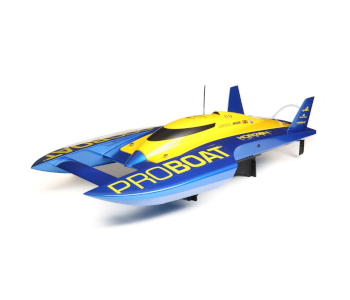
Pro Boat UL-19 RTR Brushless Powered Hydroplane
#2 Monoplane Hull
Monoplanes are the right choice for driving boats on choppy water and over waves. They’re fast too, though not as fast as hydroplanes. These are V-shaped hulls that can be either deep or shallow. The stability of a deep-V design makes them a much better choice for newbie racers. Below is an example of a ready to run (RTR) preassembled deep-V monoplane to illustrate.

Pro Boat Stealthwake RTR Brushed Powered Deep-V
#3 Catamaran Hull
Real-world catamaran or cat hull designs are typically for off-shore race boats. They have two outer projections called sponsons and a tunnel through the center. These hulls are faster and handle better than other types. Cats are an ideal choice for rough water because of the extra stability. The downside for that added stability is an increase in drag.
Below is an example of a ready to run (RTR) preassembled catamaran to illustrate.
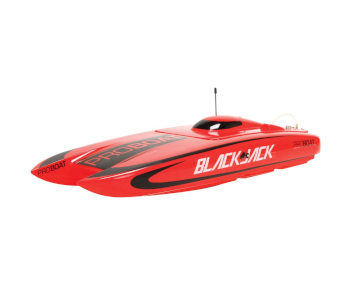
Pro Boat Blackjack RTR Brushless Powered Catamaran
#4 Tunnel hulls
Tunnel hulls are the slowest of the four but still nippy. They do handle well and are the perfect choice for driving on shallower water. These types of boats have two planing hulls that allow the craft to rise upward and glide or skim over the surface. The tunnel hull design has a solid center that traps air. Below is an example of a ready to run (RTR) preassembled F1 Tunnel hull powerboat to illustrate.
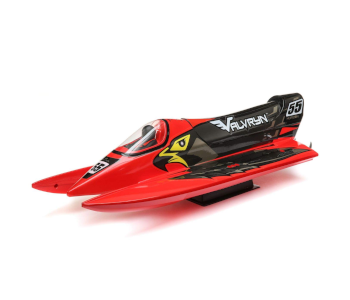
Pro Boat Valvryn RTR F1 Self-Righting Tunnel Hull Powerboat
RC Boat Power Source Options
Next, we need to look at ways to power your new RC boat. There are three options here, namely:
- Electric power (battery)
- Nitro power
- Gas power
#1 Electric Powered RC Boats
Battery power is the most common fuel source. It’s also the cleanest and needs little maintenance. Electric-powered R/C boat motors are much faster than they used to be. They also enjoy better run times and quicker charging than earlier models. Battery power is quieter than gas too, and that allows more choices on where you can play. It’s wise for newbie RC boat builders to opt for electric.
#2 Nitro Powered RC Boats
Nitro powered RC boats are driven by something called a glow engine and a special fuel mixture. The fuel uses a blend of nitro-methane, methanol, and oil, usually the castor variety. The mix ratio varies depending on the engine. Nitro boats are quite fast and well-protected from water thanks to a hydrostatic lock. These engines produce realist sounds and smoke.
Nitro-fueled engines are an excellent choice if you love to tinker, but terrible if you don’t. They need lots of tuning and regular maintenance. The engines are also very loud compared to electric.
#3 Gas Powered RC Boats
Gas-powered RC boats are big and powerful, but they’re also incredibly noisy. Using gas for a model rewards it with long running times on a full tank of fuel. However, it can be a messy business, and the engines do need regular maintenance. They’re easy to operate once set up, though, and they require less tuning that nitro. Powerful gas engines are also useful for driving on rough water.
The rest of this guide looks at the logical steps on how to make an RC boat.
RC Boat Kits Vs. Scratch Building
RC boat kits are an excellent choice for the raw novice as they’re the jigsaws of the modeling world. Everything you need to build the boat structure is in the box. A decent kit should come with detailed instructions. It shows you how to construct the model using steps and illustrations. Look for user reviews if you’re not sure. Some kits have vague instructions or suffer from poor translations.
Look for helpful online video tutorials instead if the instructions are bad. YouTube is the best place, but there may be others. Kits are not so easy to find for RC boats, and the choices are few compared to scratch building plans. Another option is to learn to build by the kit-bashing route (see next)
The Kit (Model) Bashing Route
Kit-bashing is an excellent progression toward scratch building. It works by creating an RC boat using the parts and components from commercial kits. The idea is to create a unique RC model boat from these pieces or use them to customize an existing project. The bashing approach is hands on. It teaches you all about scale modeling in a fun and enjoyable way.
Consider kit-bashing if you’re an RC fan who happens to have a bunch of spare parts sitting in boxes. RC enthusiasts are usually reluctant to throw stuff out with old or broken models. Ask others if they can donate some parts if you’re a total newbie.
Below are a few books to consider on RC model boat building, upgrades, and maintenance.
Building and Racing Radio Control Sailboats
EDITOR’S RATING: 4.8/5
This book makes an enjoyable read for anyone into radio control sailing. It uses a step-by-step format to show the reader how to get started. There are chapters on selecting a model sailboat; building from kits, and scratch building. It also shows how to install radio systems, sails, and winches, etc. It’s not a cheap book, but it will last you a lifetime once you have it.
Electric RC Boat Upgrade & Maintenance
EDITOR’S RATING: 4.7/5
A boat builder’s job is never finished. Enthusiasts love to tweak and tinker their models, and that means upgrades and maintenance. This book is for beginner to intermediate level RC’ers.
Model YACHT Construction and Sailing – Made Cheap and Easy!
EDITOR’S RATING: 4.4/5
This is a fun book aimed at folks who are not yet sure whether they want to build an RC boat or not. It gives step-by-step illustrated instructions on how to make a micro-sized RC sailing yacht. The entire process uses household tools and shouldn’t cost much more than ten dollars.
The Beauty of Scratch Building
RC boat kits have their place, but most beginners use them as stepping stones to scratch building. After all, a kit is not unique to you, but a custom model built from scratch most definitely is.
Scratch building is the way forward if you have the time and patience. There are many boat plans and blueprints around for free download or a nominal fee. Building an RC boat from scratch gives you total freedom to be as creative as you want. That means you can produce a model that no one else has. It can save you money too, but it can also take a long time depending on the model and modeler.
Where to Find RC Boat Plans
Below are examples of the type of RC boat plans and building formats available. Join an RC forum and ask for help if you can’t find the plans you want via the search engines.
RC model building is a social pastime where people swap ideas, give advice, and share tips. The RCGroups forum is an excellent place for all the above. You can browse for free, but you need to join to search. There are many threads (discussions) on this site for RC boat plans and RC building.
Plans to Make an Easy & Fast RC Boat!
This site has downloadable RC speedboat plans. It also has 19 online stepped instructions on how to build the boat. Everything is on one scrollable page with large photos to support the text. There’s a discussion going on at the end of the page with some useful feedback from visitors.
These plans are ideal for entry-level scratch builders. The boat is mostly balsa wood, and the tools needed to construct the model are basic. The cost at the time of writing was around $8.
These plans are for Build a radio control electric racing boat. They include notes and full-sized printed plans. It’s a personal project, but you’re free to modify the plans and tweak the model as you wish.
The Right Tools for the Job
Make sure you have the right precision tools to build your RC boat. Proper tools make the work so much easier and more enjoyable. The wrong tools make the job frustrating, and you risk damaging the model or yourself. There are plenty of decent kits at reasonable prices. Look at what you already have, and then make a list of what you need extra.
The examples below show basic, intermediate, and pro-level options, though there are many others. Try not to skimp here as high-quality tools will last a lifetime.
Rustark 9 Piece Gundam Model Toolset | Basic Kit

EDITOR’S RATING: 4.5/5
The Rustark 9 piece Gundam model toolset is a basic kit that costs only a few dollars. It’s a lightweight kit that comes with a plastic storage box. The tools include:
- 1 x side pliers
- 1 x manual model tools file
- 1 x penknife
- 5 x spare blades
- 1 polishing cloth
- 2 x double-sided polished bar
- 2 x tweezers
Remember, this is only a starter pack that doesn’t cost much money. You may want to invest in the higher-quality, more comprehensive toolkit if you decide to embrace RC boat building.
Hobbypark 11-in-1 Pro RC Box Set Tools | Intermediate Kit
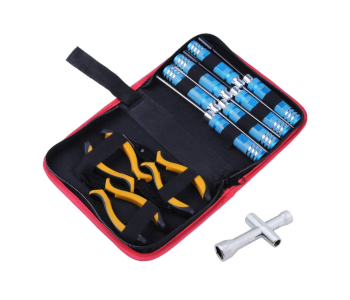
EDITOR’S RATING: 4.7/5
The Hobbypark 11-in-1 Pro Box Set contains some essential tools for RC model builders. The high-performance metal used is durable and long-lasting. This set includes the following items:
- 1 x hex screwdriver 1.5mm
- 1 x hex screwdriver 2.0mm
- 1 x hex screwdriver 2.5mm
- 1 x box spanner 4.0mm
- 1 x box spanner 5.5mm
- 1 x Philips screwdriver 0#+
- 1 x slot screwdriver 1#-
- 1 x pliers (needle-nose)
- 1 x pliers (diagonal)
- 1 x Pliers (ball link)
- 1 x Hexagon Sleeve Wrench (4/5/5.5/7mm)
This kit is ideal for building, maintenance, and repair. It doesn’t include saws or drill bits, though.
X-ACTO Hobbytool Set Deluxe 30 Piece Set | Pro Kit
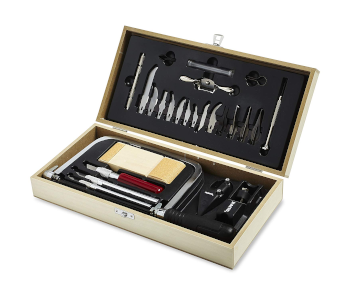
EDITOR’S RATING: 4.8/5
The X-ACTO Hobbytool is a 30 piece, high-quality modelers toolkit. It has precision tools to saw, whittle, cut, and carve a variety of materials. The set includes the following items:
- 3 x X-ACTO knives: #1/2/5
- 11 x X-ACTO blades: #2, 7/11/13/16/17/19/22/24/26/28
- 1 x jeweler’s screwdriver
- 1 x block plane
- 1 x block sander
- 1 x spokeshave
- 1 x balsa stripper
- 2 x routers
- 4 x gouges
- 1 x pin vise
- 3 x drill bits
- 1 x coping saw (includes blade)
- 1 x wood storage box
These are three examples of the toolkits available, but there are many others. It can be hard for the first-time builder to know what they need for their radio control model. Proper preparation makes everything so much easier, so ask in RC forums if you need some guidance.
Other Tools to Consider
There are a few other tools to consider. A building board to lay your plans on, to work, and organize parts as you build is essential. This board is not your workbench—it goes on top of it. The board can be whatever size and material works best for you, and you can make your own or buy a purpose product. Again, seek help from fellow modelers if you’re unsure.
You may need electrical devices depending on the type of boat you build. There are various other things too. Here’s a breakdown of some potential tools and items to consider.
| Support Tools | Electrical Tools | MISC. ITEMS |
|---|---|---|
| Building board | Dremel tool Sealing iron Electric drill Heat gun Soldering iron | Balsa Wood Filler CA, Epoxy Glue Masking tape Sandpaper Sanding Block String Solder |
Most homes will at least have some of the tools needed for RC model boat building. Find out what you need extra and get everything prepared before you start to build.
How to Build Your Firsts RC Boat
I use a basic RC vessel here to illustrate the building basics. It’s a broad approach and doesn’t refer to any particular model. The principles are similar for most boat building. Despite that, size, complexity, and skill level will differ between projects. The model below is a simplistic electric-powered vessel. I base this example on sourced parts, so there are no tutorials on how to make individual pieces.
The parts of your RC boat from rear (R) middle (M) to front (F) are:
- Rudder (R)
- Servo horn (R) servo rod (R–M) servo (M)
- Battery (R)
- Receiver (F)
OK, now let’s look at how it all goes together.
Choose the Hull
The hull of your boat is what everything else works around. You may want to make one or buy a ready-made product that fits your design. Either way, choose a hull right at the start of the project. Refer to the ‘types of hull’ section if you need a recap.
The Electronics
The hull and electronics are the most expensive items on an RC boat builders list. Despite that, they don’t have to cost the earth, especially if you start with a toy-grade project. The electronics include:
- Motor
- Servo
- Rechargeable battery
- Battery charger
- Radio system (transmitter/receiver)
Attach the motor
The motor goes at the bottom rear of the model boat, usually under where the battery sits. Fix it in place using purpose modeling glue and then attach the prop.
Waterproof the boat’s openings
It’s time to waterproof the boat’s opening (hatch). It’s a vital step as water always finds a way in if there is one. There are different approaches to this, and no two boats are the same. However, the favorite way is to build a wall around the opening. It’s what we call ‘coaming’ in the RC world, and it’s a raised edge that surrounds the open hatch.
Balsa strips work well for coaming—which must be slightly proud of the boat’s deck. You can then build a simple removable hatch to seal the opening. Model boat builders use all kinds of creative ways to seal the openings. Seek help on one of the forums if you need guidance.
Attach the steering servo
Servos come in many different shapes, weights, and sizes, but they all work the same basic way. A servo’s arm should correspond precisely with the transmitter’s stick or slider movements. The servo is necessary for steering your RC vessel, and it goes in the hull towards the front of the boat.
There are various ways to install the servo into the hull. The three most common are:
- Double-sided tape
- Glue directly to the bottom of the hull
- Glue wood blocks inside the hull and screw the servo to the blocks
The first two options are okay if you build a cheap, toy-grade product as a first experiment. Option 3 is a better approach for costlier, high-powered boats. You can also make a purpose servo mount with brackets and screws for added security. This way you can access and remove the servo easily should you need to replace or maintain it.
Attach the boat’s rudder
You can make the boat’s rudder or buy one. You must take it apart to install it if you purchased a rudder assembly. Make a note of the parts and how they go together as you strip it down.
The rudder goes at the back of the boat, fastened outside its hull. You need to drill a hole for the rudder tube on the model’s center line just behind the prop. The trick here is to use a drill bit that’s only slightly larger than the pipe. This is where your precision tools come in handy. Here are the remaining steps assuming the above went as planned.
- Place the servo horn on the top of the rudder tube
- Use a screw to secure the servo horn
- Attach the servo rod with Z-bends at both ends
That’s it. Your rudder assembly should now be in place and ready to go.
Attach the battery pack
You model RC boat is now ready for its battery pack, and there are two main options here. One is to glue the rechargeable battery to the bottom of the boat’s hull. The downside to gluing is that the battery becomes fixed. That means you must wait for it to charge before you can use the boat again.
Velcro is a better method if you want to be able to swap batteries over. Glue one piece of quality Velcro to the bottom of the hull and the other to the battery. Space might be tight, so make sure the servo rod doesn’t make contact. Now connect the battery cable to the power plug.
Attach the receiver
Now it’s time to glue the receiver into place. It goes at the front (the bow) of the boat.
Seal the boat
You can waterproof your RC boat using various sealants depending on the material used. Some modelers like to waterproof the inside and outside to be extra safe. For wood hulls, Z-Poxy Finishing Resin Adhesive is a popular choice. ABS hulls do better with a clear waterproof silicone like DAP. Ask on forums if you’re unsure, and let others know some details about your boat and its materials.
Good luck with your next project.

